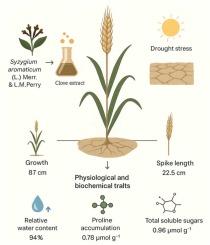Green-synthesized copper nanoparticles enhance drought tolerance in wheat for sustainable biomass and industrial applications
IF 6.2
1区 农林科学
Q1 AGRICULTURAL ENGINEERING
引用次数: 0
Abstract
Drought stress severely limits the growth, physiological performance, and yield of Triticum aestivum L. (wheat), particularly under water-limited conditions relevant to industrial and bioenergy applications. This study evaluated the potential of green-synthesized copper nanoparticles (CuNPs), produced using Syzygium aromaticum (L.) Merr. & L.M.Perry) (clove) extract, to enhance drought tolerance in four wheat varieties—Dharab-11, Watan-94, Faisalabad-2008, and Faisalabad-2010—selected based on contrasting stress sensitivity and germination performance. Copper nanoparticles with an average crystalline size of 23.6 nm were applied as foliar sprays at 10, 20, and 30 ppm, while drought stress was imposed at the grain-filling stage by withholding irrigation for 15 days, reducing soil moisture to approximately 40 % of field capacity. CuNP supplementation, particularly at 30 ppm, significantly improved growth, physiological, and biochemical traits under drought. Dharab-11 exhibited the tallest plants (87 cm), Watan-94 maintained the largest leaf area (52 cm²), and Watan-94 also produced the longest spikes (22.5 cm). Relative water content increased up to 94 %, while proline accumulation reached 0.78 µmol g⁻¹ fresh weight, reflecting enhanced osmotic adjustment. Total soluble sugars increased up to 0.96 µmol g⁻¹ fresh weight, supporting cellular turgor and metabolic stability under stress. Yield components, including spikelet number and 1,000-grain weight, were also positively influenced. These findings demonstrate that clove-extract-mediated CuNPs provide a novel, eco-friendly approach to mitigate drought-induced morphological, physiological, and biochemical impairments in wheat. Future field trials are recommended to validate scalability, assess nanoparticle persistence in soil, and evaluate potential phytotoxicity at higher concentrations.

绿色合成的铜纳米颗粒增强小麦的耐旱性,用于可持续生物质和工业应用
干旱胁迫严重限制了小麦的生长、生理性能和产量,特别是在与工业和生物能源应用相关的缺水条件下。本研究评估了绿色合成铜纳米颗粒(CuNPs)的潜力。稳定。L.M.Perry)(丁香)提取物,以提高四个小麦品种——达拉-11、瓦丹-94、费萨拉巴德-2008和费萨拉巴德-2010的耐旱性,这些小麦品种是根据对比胁迫敏感性和发芽性能选择的。在叶片喷施10、20和30 ppm的平均晶粒尺寸为23.6 nm的铜纳米颗粒,而在灌浆阶段施加干旱胁迫,暂停灌溉15天,使土壤水分减少到约40% %的田间容量。在干旱条件下,添加CuNP,特别是在30 ppm时,显著改善了生长和生理生化性状。植株最高的是“达拉11”(87 cm),叶片面积最大的是“Watan-94”(52 cm²),穗最长的是“Watan-94”(22.5 cm)。相对含水量增加了94 %,脯氨酸积累达到0.78µmol g⁻¹ 鲜重,反映了渗透调节的增强。总可溶性糖增加到0.96µmol g(⁻¹ ),在压力下支持细胞膨胀和代谢稳定。小穗数、千粒重等产量组成部分也受到正向影响。这些发现表明,丁香提取物介导的CuNPs为减轻小麦干旱诱导的形态、生理和生化损伤提供了一种新颖、环保的方法。未来的田间试验建议验证可扩展性,评估纳米颗粒在土壤中的持久性,并评估高浓度下潜在的植物毒性。
本文章由计算机程序翻译,如有差异,请以英文原文为准。
求助全文
约1分钟内获得全文
求助全文
来源期刊

Industrial Crops and Products
农林科学-农业工程
CiteScore
9.50
自引率
8.50%
发文量
1518
审稿时长
43 days
期刊介绍:
Industrial Crops and Products is an International Journal publishing academic and industrial research on industrial (defined as non-food/non-feed) crops and products. Papers concern both crop-oriented and bio-based materials from crops-oriented research, and should be of interest to an international audience, hypothesis driven, and where comparisons are made statistics performed.
 求助内容:
求助内容: 应助结果提醒方式:
应助结果提醒方式:


